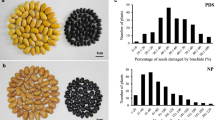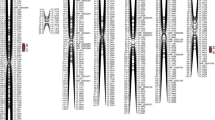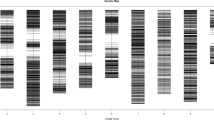Abstract
Cluster bean [Cyamopsis tetragonoloba (L.) Taub] is an important leguminous crop of India, accounting for nearly 80% of the global production. The seeds of this economically important crop are used in various industrial applications worldwide like, textile, cosmetics, pharmaceuticals, mining, petroleum, natural gas, oil industries etc. Despite such high economic value, the productivity of this crop is quite low. One such major constraint in the production of cluster bean is bacterial leaf blight disease caused by Xanthomonas campestris pv. Cyamopsidis. Yield losses of up to 58–68% have been reported in case of severe infestation. Therefore, there is a need to formulate suitable breeding strategies to overcome the yield losses. But the lack of complete understanding of underlying genomic base in cluster bean is a major constraint in developing high-yielding and resistant cultivars/varieties. Here we report the first linkage map construction at the level of interspecific polymorphism using F3-4 segregating population based on Cyamopsis’s the basis of microsatellite markers of cluster bean and other legume crops which can further advance the breeding programs. An interspecific cross was developed in our laboratory using a bacterial blight resistant wild species (C. serrata Schinz.) and a moderately susceptible with high gum content cultivar (HG563). A total of 177 SSRs comprising EST-SSRs from cluster bean and ESTs as well genomic SSRs from other legumes were used in molecular analysis and 38 SSRs were found polymorphic. Linkage analysis revealed that nine markers (CBN21, CBN16, CBN17, CTF234, CBN03, CBN11, CTN15, CTN14, and GDR22) formed a single linkage group spanning 190 cM of cluster bean genome. Four minor QTLs were identified in interspecific cross for plant height (qPH1.1), hundred seed weight (qHSW1.1), disease resistance (qPDI1.1), and gum content (qGC1.1) mapped on single linkage group at 39.41, 123.41, 112.41 and 102.41 cM, respectively. The LOD values for all four QTLs ranged from 3.3 to 15.5. (above the threshold LOD > 3.0). Marker interval of CTN15 and CTN14 spanning 35.4–190.0 cM distance harboured all the four QTLs. Interestingly, plant height QTL was found only 4.8 cM apart from CTN 15 SSR marker, which can be exploited further for cluster bean improvement programs in future.








Similar content being viewed by others
References
Aditi (2018) EST-SSR and RGA polymorphism for diversity analysis and Bacterial Leaf Blight in cluster bean [Cyamopsis tetragonoloba (L.) Taub.]. Ph.D. thesis submitted to CCS Haryana Agricultural University, Hisar, Haryana
Ali S, Mir ZA, Tyagi A, Bhat JA, Chandrashekar N, Papolu PK, Rawat S, Grover A (2017) Identification and comparative analysis of Brassica juncea pathogenesis-related genes in response to hormonal, biotic and abiotic stresses. Acta Physiol Plant 39(12):1–15. https://doi.org/10.1007/s11738-017-2565-8
Anil PSK, Kadian P, Gandhi SK, Bhusal N (2012) Inheritance of bacterial leaf blight resistance in cluster bean. Forage Research 38(3):182–183
Arjun K, Dhaliwal MS, Jindal SK, Fakrudin B (2018) Mapping of fruit length related QTLs in interspecific cross (Capsicum annuum L. × Capsicum galapagoense Hunz.) of chilli. Breed Sci 68(2):219–226. https://doi.org/10.1270/jsbbs.17073s
Bai Y, Michaels TE, Pauls KP (1997) Identification of RAPD markers linked to common bacterial blight resistance genes in Phaseolus vulgaris L. Genome 40(4):544–551. https://doi.org/10.1139/g97-071
Boghara MC, Dhaduk HL, Kumar S, Parekh MJ, Patel NJ, Sharma R (2016) Genetic divergence, path analysis and molecular diversity analysis in cluster bean (Cyamopsis tetragonoloba L. Taub.). Ind Crop Prod 89:468–477. https://doi.org/10.1016/j.indcrop.2016.05.049
Chanbane K, Ablett GA, Cordeiro GM, Valkoun J, Henry RJ (2005) EST versus genomic derived microsatellite markers for genotyping wild and cultivated barley. Genet Resour Crop Evol 52(7):903–909. https://doi.org/10.1007/s10722-003-6112-7
Chen H, Liu L, Wang L, Wang S, Somta P, Cheng X (2015) Development and validation of ESTSSR markers from the transcriptome of adzuki bean (Vigna angularis). PLoS ONE 10(7):e0131939. https://doi.org/10.1371/journal.pone.0131939
Cho YG, Ishii T, Temnykh S, Chen X, Lipovich L, McCouch SR, Park WD, Ayres N, Cartinhour S (2000) Diversity of microsatellites derived from genomic libraries and GenBank sequences in rice (Oryza sativa L.). Theor Appl Genet 100:713–722. https://doi.org/10.1007/s001220051343
Coveney PV, Silva HD, Gomtsyan A, Whiting A, Boek ES (2000) Novel approaches to cross-linking high molecular weight polysaccharides: application to guar-based hydraulic fracturing fluids. Mol Simul 25:265–299. https://doi.org/10.1080/08927020008024503
Das B, Arora SK, Luthra YP (1977) A rapid method for determination of gum in guar (Cyamopsis tetragonoloba (L.) Taub.). in Proceedings of the 1st Institute for Conflict Analysis and Resolution Workshop (CAZRI '77), pp. 117–123, Jodhpur, India
Eujayl I, Sorrells M, Baum M, Wolters P, Powell W (2001) Assessment of genotypic variation among cultivated durum wheat based on EST-SSRs and genomic SSRs. Euphytica 119(1–2):39–43. https://doi.org/10.1023/a:1017537720475
Gaitán-Solís E, Duque MC, Edwards KJ, Tohme J (2002) Microsatellite repeats in common bean (Phaseolus vulgaris): isolation, characterization, and cross-species amplification in Phaseolus ssp. Crop Sci 42:2128–2136. https://doi.org/10.2135/cropsci2002.2128
Gandhi SK, Chand JN (1985) Yield losses in cluster bean due to bacterial blight caused by Xanthomonas campestris pv. cyamopsidis. Indian Phytopathol 38:516–519
Gillett JB (1958) Indigofera (Microcharis) in tropical Africa with the related genera Cyamopsis and Rhynchotropis. Kew Bull Addit Series 1:1–166
Gresta F, Avola G, Cannavo S, Santonoceto C (2018) Morphological, biological, productive and qualitative characterization of 68 guar (Cyamopsis tetragonoloba (L.) geotypes. Ind Crops Prod 114:98–107. https://doi.org/10.1016/j.indcrop.2018.01.070
Grisi MCM, Blair MW, Gepts P, Brondani C, Pereira PAA, Brondani RPV (2007) Genetic mapping of a new set of microsatellite markers in a refernce common bean (Phaseolus vulgaris) population BAT93 x Jalo EEP558. Genet Mol Res 6(3):691–706
Heffner EL, Lorenz AJ, Jannink JL, Sorrells ME (2010) Plant breeding with genomic selection: gain per unit time and cost. Crop Sci 50(5):1681–1690. https://doi.org/10.2135/cropsci2009.11.0662
Jaradat AA (2016) Breeding oilseed crops for climate change. In: Gupta SK (ed) Breeding oilseed crops sustain prod. Academic Press, Cambridge, pp 421–472
Jiang G (2013) Molecular markers and marker-assisted breeding in plants. In (Ed.), Plant breeding from laboratories to fields. IntechOpen, London, pp 45–83 https://doi.org/10.5772/52583
Joshi UN (2004) Advances in chemistry, biochemistry and industrial utilization of guar seed. In: Guar JV Singh, Dahiya BS (Eds.), p. 197, Indian Society of Forage Research, Hisar and Agricultural and Processed Food Products Export Development Authority (APEDA), New Delhi, India 229
Kaur A (2014) Molecular marker analysis for bacterial blight resistance in cluster bean (Cyamopsis tetragonoloba (L.) Taub.). M.Sc. thesis submitted to CCS Haryana Agricultural University, Hisar
Kim YC, Kim SY, Choi D, Ryu CM, Park JM (2008) Molecular characterization of a pepper C2 domain-containing SRC2 protein implicated in resistance against host and non-host pathogens and abiotic stresses. Planta 227(5):1169–1179. https://doi.org/10.1007/s00425-007-0680-2
Kumar S, Modi AR, Parekh MJ et al (2017) Role of conventional and biotechnological approaches for genetic improvement of cluster bean. Ind Crops Prod 97:639–648. https://doi.org/10.1016/j.indcrop.2017.01.008
Kumar S, Palve AS, Patel SK, Selvanayagam S, Sharma R, Rathore A (2020) Development of genomic microsatellite markers in cluster bean using next-generation DNA sequencing and their utility in diversity analysis. Curr Plant Biol 21:100134. https://doi.org/10.1016/j.cpb.2019.100134
Kuravadi NA, Tiwar PB, Tanwar UK, Tripathi SK, Dhugga KS, Gill KS, Randhawa GS (2014) Identification and characterization of EST-SSR markers in cluster bean (Cyamopsis spp.). Crop Sci 54(3):1097–1102. https://doi.org/10.2135/cropsci2013.08.0522
Lincoln SE, Lander SL (1993) Mapmaker/exp 3.0 and mapmaker/qtl 1.1. Technical report. Whitehead Institute of Medical Research, Cambridge, Mass
Liu Q, Liu H, Gong Y, Tao Y, Jiang L, Zuo W, Yang Q, Ye J, Lai J, Wu J, Lübberstedt T (2017) An atypical thioredoxin imparts early resistance to Sugarcane mosaic virus in maize. Mol Plant 10(3):483–497. https://doi.org/10.1016/j.molp.2017.02.002
Mali PC, Vyas SP, Lodha S (1989) Biochemical com- ponents of clusterbean genotypes in relation to bacterial blight. Indian Phytopathol 42:559–561
Manivannan A, Anandakumar CR, Ushakumari R, Dahiya GS (2015) Genetic diversity of cluster bean genotypes (Cyamopsis tetragonoloba (L.) Taub.) based on agro-morphologicaltraits. Bangladesh J Bot 44:59–65
Mihail JD, Alcorn SM (1985) Bacterial blight (Xanthomonas campestris pv. cyamopsidis) of guar in Arizona. Plant Dis 69:811. https://doi.org/10.1094/PD-69-811c
Morgante M, Hanafey M, Powell W (2002) Microsatellites are preferentially associate with nonrepetitive DNA in plant genomes. Nat Genet 30:194–200. https://doi.org/10.1038/ng822
Mudgil D, Barak S, Khatkar BS (2014) Cluster bean gum: processing, properties and food applications—a review. J Food Sci Technol 51(3):409–418. https://doi.org/10.1007/s13197-011-0522-x
Murwan KS, Abdalla AH (2008) Yield and yield components of forty-five cluster bean (Cyamopsis tetragonoloba) genotype grown in Sudan. Nile Basin Research Journal 11(4):48–54
Patel AJ, Patel MK (1958) A new bacterial blight in Cyamopsis tetragonoloba (L). Taub Curr Sci 27:258–259
Patel MK, Dhande GW, Kulkarni YS (1953) Bacterial leaf-spot of Cyamopsis tetragonoloba(L.) Taub. Curr Sci 22:183
Raju NL, Gnanesh BN, Lekha P, Jayashree B, Pande S, Hiremath PJ, Byregowda M, Singh NK, Varshney RK (2010) The first set of EST resource for gene discovery and marker development in pigeonpea (Cajanus cajan L.). BMC Plant Biol 10:45. https://doi.org/10.1186/1471-2229-10-45
Rawal HC, Kumar S, Mithra SVA, Solanke AU, Nigam D, Saxena S, Tyagi AVS, Yadav NR, Kalia P, Singh NP, Singh NK, Sharma TR, Gaikwad K (2017) High quality Unigenes and microsatellite markers from tissue specific transcriptome and development of a databse in cluster bean (Cyamopsis tetragonoloba, L. Taub). Genes 9:8–11. https://doi.org/10.3390/genes8110313
Reddy DS, Nagare PK, Reddaiah K, Reddy BR (2014) Effect of integrated nutrient management on growth, yield, yield attributing characters and quality characters in cluster bean (Cyamopsis tetragonoloba (L.) Taub.). The Ecoscan 4:329–332
Reddy DR, Saidaiah P, Reddy KR, Pandravada SR, Geetha A (2018) Genetic variability for growth, pod and quality attributes in germplasm of cluster bean [Cyamopsis tetragonoloba(L.) Taub.]. Legum Res 3917:1–5. https://doi.org/10.18805/LR-3917
Russell J, Booth A, Fuller J, Harrower B, Hedley P, Machray G, Powell W (2004) A comparison of sequence-based polymorphism and haplotype content in transcribed and anonymous regions of the barley genome. Genome Biol 47(2):389–398. https://doi.org/10.1139/g03-125
Sheoran OP, Tonk DS, Kaushik LS, Hasija RC, Pannu RS (1998) Statistical Software Package for Agricultural Research Workers. Recent Advances in information theory, Statistics and computer applications by D S Hooda and R C Hasija Department of Mathematics Statistics, CCSHAU, Hisar. Pp. 139–143
Singh N, Singh H, Nagarajan P (2013) Development of SSR markers in mung bean, Vigna radiata (L.) Wilczek using in silico methods. J Crop Weed 9(1):69–74
Sombir (2013) Interspecific hybridization in cluster bean (Cyamopsis tetragonoloba) using biotechnological approaches. M.Sc. thesis submitted to CCS Haryana Agricultural University, Hisar
Srivastava DN, Rao YP (1963) Seed transmission and epidemiology of the bacterial leaf blight disease of rice in north India. Indian Phytopathol 14:77–78
Swada K, Hasegawa M, Tokuda L, Kameyama J, Kodama O, Kohchi T, Yoshida K, Shinmyo A (2004) Enhanced resistance to blast fungus and bacterial blight in transgenic rice constitutively expressing OsSBP, a rice homologue of mammalian selenium-binding proteins. Biosci Biotechnol Biochem 68(4):873–880. https://doi.org/10.1271/bbb.68.873
Tanwar UK, Pruthi V, Randhawa GS (2017) RNA-Seq of Cluster bean (Cyamopsis tetragonoloba, L. Taub.) Leaves: de novo transcriptome assembly, functional annotation and development of genomic resources. Front Plant Sci 8(91):1–15. https://doi.org/10.3389/fpls.2017.00091
Undersander DJ, Putnam DH, Kaminski AR, Kelling KA, Doll JD, Oplinger ES, Gunsolus JL (1991) Guar. Alternative Field Crop Manual University of Wisconsin Cooperative Extension Service, University of Minnesota Extension Service, Center for Alternative Plant and Animal Products, 1991. https://hort.purdue.edu/newcrop/afcm/guar.html
Wadhwa N (2015) Analysis of simple sequence repeats and key enzymes for galactomannan content in cluster bean [Cyamopsis tetragonoloba (L.) Taub.] genotypes. Ph.D. thesis submitted to CCS Haryana AgriculturalUniversity, Hisar. pp 108
Wheeler BEJ (1969) An introduction to plant diseases. John & Wiley and Sons, New York
Whistler RL, Hymowitz T (1979) Cluster bean: agronomy, production, industrial use, and nutrition. Purdue University Press, West Lafayette
Xu Y (2010) Molecular plant breeding. CABI, Wallingford, p 736 (978-1-84593-392-0)
Xu P, Jiang L, Wu J, Li W, Fan S, Zhang S (2014) Isolation and characterization of a pathogenesis-related protein 10 gene (GmPR10) with induced expression in soybean (Glycine max) during infection with Phytophthora sojae. Mol Biol Rep 41(8):4899–4909. https://doi.org/10.1007/s11033-014-3356-6
Acknowledgements
Not applicable
Funding
This work was supported by a grant from the Director of Research, CCS Haryana Agricultural University, Hisar, India [C(a) BMB-6-Plan (Agri.)].
Author information
Authors and Affiliations
Contributions
NRY and RCY conceived and designed the research. P executed the experiments and performed the analysis. N RY and RCY reviewed the results. SKP and RP collaborated in the field experiments and reviewed the morphological data. P wrote the draft manuscript. NRY and RCY edited the final manuscript.
Corresponding author
Ethics declarations
Conflict of interest
The authors declare that they have no competing interest.
Additional information
Publisher's Note
Springer Nature remains neutral with regard to jurisdictional claims in published maps and institutional affiliations.
Supplementary Information
Below is the link to the electronic supplementary material.
Rights and permissions
Springer Nature or its licensor (e.g. a society or other partner) holds exclusive rights to this article under a publishing agreement with the author(s) or other rightsholder(s); author self-archiving of the accepted manuscript version of this article is solely governed by the terms of such publishing agreement and applicable law.
About this article
Cite this article
Priti, Panchta, R., Yadav, R.C. et al. Linkage mapping and identification of quantitative trait loci associated with bacterial leaf blight resistance and gum content in cluster bean using the interspecific population (HG563 × Cyamopsis serrata). Genet Resour Crop Evol 70, 1501–1516 (2023). https://doi.org/10.1007/s10722-022-01517-0
Received:
Accepted:
Published:
Issue Date:
DOI: https://doi.org/10.1007/s10722-022-01517-0




